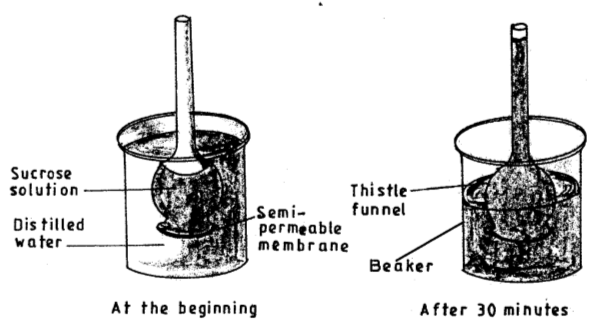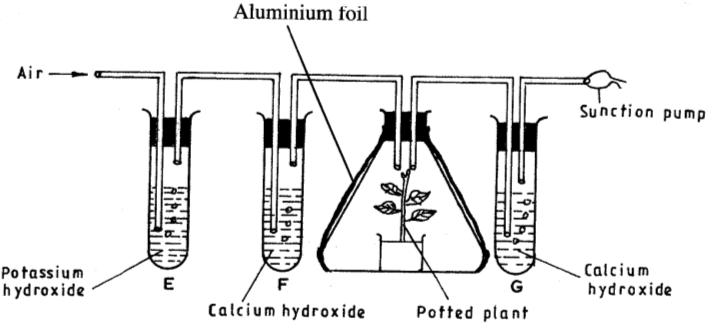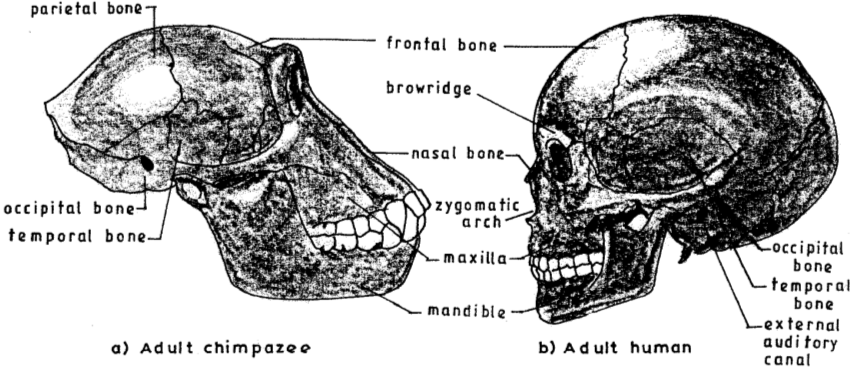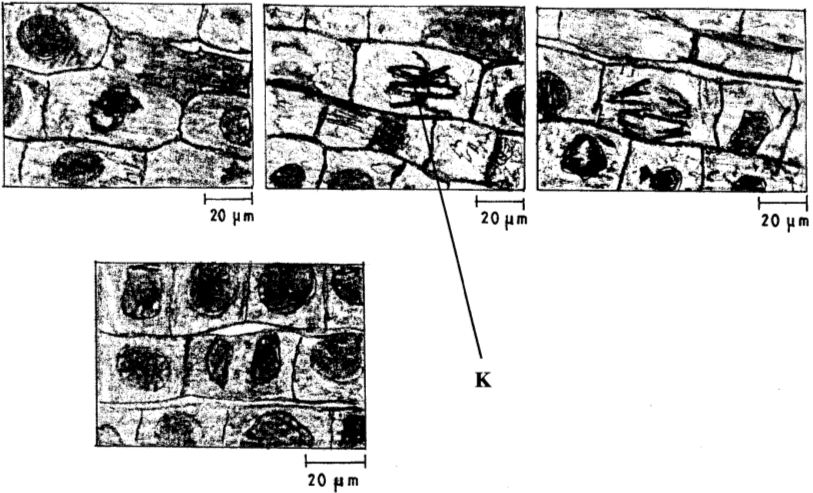Answer all the questions in the spaces provided.
-
- What is meant by the term binomial nomenclature? (1 mark)
- state two guidelines that should be followed when typing scientific names. (2 marks)
- During a lesson, students observed the structures of bat, cat and human forelimbs to determine their evolutionary relationship.
- State the name given to the structure of the limbs observed by the students. (1 mark)
- Name the type of evolution illustrated by the structure of the limbs observed. (1 mark)
- What evidence of evolution is illustrated by limbs? (1 mark)
- State the significance of the type of evolution illustrated by the limbs. (1 mark)
- An individual is of blood group B positive.
- Name the antigens in the individual’s blood. (2 marks)
- Give the reason why the individual cannot receive blood from a blood group A donor. (2 marks)
- Colour blindness is a sex linked trait controlled by recessive gene b. If a mother is a carrier and the father is normal, what is the chance that their son will be colour blind? Show your working. (4 marks)
-
- State two advantages of using a coverslip when preparing a specimen for observation under a light microscope. (2 marks)
- How is the low power objectives lens manipulated to focus a specimen for observation under a light microscope (2 marks)
- Students set up an experiment as illustrated below.

- Name the physiological process that resulted in the observation made after 30 minutes (1 mark)
- State the importance of the physicaological process investigated in plants. (1 mark)
- Explain the observation made after 30 minutes. (2 marks)
- How is a guard cell structurally adapted for gaseous exchange? (4 marks)
-
- Name the organism that:
- Causes malaria; (1 mark)
- Transmits malaria. (1 mark)
- State two control measures for malaria. (2 marks)
- Name the organism that:
- The diagram below shows an experiment set up to investigate a certain physiological process in plants.

- State the aim of the experiment. (1 mark)
- State the role of the following in the experiment:
- potassium hydroxide; (1 mark)
- aluminium foil (1 mark)
- Accounts for the expected colour change in tube F.
- The diagram below illustrate the skull of adult human and chimpanzee.

- State one difference between the two skull in the following structures: (3 marks)
Structure Chimpanzee Skull Human Skull (i) Parietal bones (ii) Mandible (iii) Browridge - State the significance of the evolution observed on the parietal bone in the chimpanzee and human. (1 mark)
- State one difference between the two skull in the following structures: (3 marks)
- Name two structures used for gaseous exchange in plants. (2 marks
-
- What is meant by each of the following:
- pyramid of numbers? (1 mark)
- pyramid of biomass? (1 mark)
- During an ecological visit to the Savanna Grassland, students were able to see lions, antelopes, vultures and pastoralists grazing their cattle. Construct a food chain with consumer levels to illustrate the energy flow in the ecosystem. (2 marks)
- What is meant by each of the following:
- State three differences between the end products of mitosis and meiosis.
Mitosis Meiosis -
- Name two types of involuntary muscles in mammals. (2 marks)
- state the location of each of the muscles named in (a) above. (2 marks)
- The photomicrograph below shows the various stages of cell division in a certain plant.
-
- Name the type of cell division illustrated. (1 mark)
- Give a reason for your answer in (a)(i) above. (1 mark)
-
- Name the stage cell division labelled K. (1 mark)
- Give a reason for your answer in (b)(i) above. (1 mark)
-
- State four structural differences between millipedes and centipedes. (4 marks)
Millipedes Centipedes -
- How is a human stomach adapted to
- protein digestion? (2 marks)
- churning? (2 marks)
- What happens to the glucose synthesized during photosynthesis? (2 marks)
- How is a human stomach adapted to
-
- The diagram below shows an experimental set-up to investigate the conditions necessary for germination.Test tube P was placed in a refrigerator while Q was left at room temperature. The set-ups were observed regularly for two weeks but no germination occurred.

- Explain the observations in P and Q. (2 marks)
p
Q
- The diagram below shows an experimental set-up to investigate the conditions necessary for germination.Test tube P was placed in a refrigerator while Q was left at room temperature. The set-ups were observed regularly for two weeks but no germination occurred.
-
- Using the axes provided below, sketch a curve to illustrate the growth pattern observed in the phylum arthropoda. (2 marks)
- Explain the growth pattern observed observed in arthropods.
- Below are components of a simple reflex pathway
- intercourse
- muscles
- motor neurone
- sensory neurone
- pain receptor
- central nervous system
List the components in their proper sequences during the transmission of a nerve impulse. (3 marks)

MARKING SCHEME
-
- The scientific system of giving two names (Genus and species) to living organisms; (1 mark)
- The Genus name starts with a capital letter while the species name starts with a small letter; The two names are typed in italics/two names underlined separately; (2 marks)
-
- The pentadactyl limb/homologous structures; (1 mark)
- Divergent evolution/adaptive radiation; (1 mark)
- Comparative anatomy; (1 mark)
- It allows the organisms to exploit different habitats to reduce competition; (1 mark)
-
- (Antigen) B;
Rhesus (antigen)/Rheus factor/Antigen D - Has antibody a in the blood plasma of the recipient and will correspond with antigen A in the donor's blood, hence there will be antigen antibody reaction/agglutination.
- (Antigen) B;

OR
Punnet square
Parental genotypes XBXb x XBY
XB Y XB XBXB XB Y Xb XBXb XbY -
-
- To hold the specimen in place;
- Protects specimen from dehydration/drying up/dust particles;
Protect objective lens from staining. (2 marks)
- Click the low power objective lens into position. Bring it down to the lowest level using the coarse adjustment knob; With eyes on the eyepiece lenses and using the coarse adjustment knob gradually raise/ lower the low power objective lens to bring the specimen into focus; (2 marks)
-
-
- Osmosis; (1 mark)
- Absorption of water from the soil; opening and closing of stoma; feeding in insectivorous plants; support (in seedlings, leaves,herbaceous plants); Movement of water from cell to cell in plants. Any correct 1 (1 mark)
- The thistle funnel gained water by osmosis; because the sucrose solution was hypertonic; (2 marks)
-
- Thin/elastic outer wall; it bulges outwards;
- Thick/less elastic inner wall; it curves to open the stomata/straightens to close the stomata;
- Has chloroplasts; for photosynthesis/synthesizedd sugar (glucose/sucrose/fructose) that is osmotically active.(4 marks)
-
-
- Plasmodium spp/malariae, vivax, Ovale, falseparum;
- Anopheles female mosquito; (2 marks)
-
- Controlling mosquitoes/vectors/cleaning breeding sites/draining stagnant water/use of insecticides;
- Vaccination/taking prophylactic drugs;
- Sleeping under mosquito nets / use of mosquito repellants. Any two correct (owtte)(2 marks)
-
-
- To show that carbon (IV) oxide is produced during respiration in plants;
-
- Absorb carbon (IV) oxide from the incoming) air;
- Exclude light / to prevent photosynthesis;(1 mark)
- No colour change in tube F / no observable colour change. Carbon (IV) oxide removed/absorbed from air by potassium hydroxide. (2 marks)
-
Structure Chimpanzee Skull Human Skull Parietal bones - less curved/flatter
- towards the back
- smaller- more curved
- more central Any correct
- larger 1 markMandibles larger smaller 1 mark Browridge - thicker /more protruding
- conspicuous/prominent- less protruded 1 mark
- less conspicuous/prominent- Accommodate large sized brain in humans; (1 mark)
-
- Stomata (in leaves);
- Lenticels (in stems and roots)/pneumatophores;
- Epidermis (roots)
- Cuticle
-
-
- Pyramid of biomas represents total dry mass weight of organisms in each trophic level;
- While pyramid of numbers represents the total number of organisms at each trophic level/feeding levels/nutrition levels; (2 marks)
- Appropriate examples for;
Grass (Vegetation) Cattle(antelope) Man(pastoralist) Lion Vulture
Producer → Primary consumer → Secondary consumer → Tertiary consumer → Quartiranery consumer (2 marks)
-
(3 marks)Mitosis Meiosis two daughter cells
- Daughter cells diploid
- Identical to mother cell/no variation- Four daughter cells
- Daughter cells haploid/are gametes
- Results in variation-
- Smooth muscles/visceral muscles;
Cardiac muscles; - Smooth muscles - tubular visceral organs; (1 mark)
Cardiac muscles - heart (1 mark)
- Smooth muscles/visceral muscles;
-
-
- Mitosis;
- Formation of two daughter cells.(2 marks)
-
- Metaphase;
- Chromosomes are at the equator. (2 marks)
-
- Millipedes
- Cylindrical body
- Each segment has two pairs of walking
- legs (except the first thoracic segment)
- Head has two clumps of many simple eyes
- Head has a pair of long antennae
- No poison claws
- Three body parts - head short, throrax, and trunk
- Has anterior genital aperture
- Has 9 - 100 segments
Centipedes - Dorso - ventrally flattened
- Head has a pair of simple eyes
- Each segment has a pair of waking legs
- Head has a pair of short antennae;
- Has poison claws
- Two body parts - head and trunk
- Has aposterior genital aperture
- Has 15 - 21 segments (4 marks)
-
-
- Has gastric glands; that secrete gastric juice; (2 marks)
- Thick muscular wall; that contract and relax;
Accept a component of gastric juice (pepsin, Rennin, mucus, hydrochloric acid). (2 marks)
-
- Used in plant respiration to produce energy;
- Converted to starch/sucrose/lipids/proteins/cellulose and stored; for future use. (2 marks)
-
- P- the low temperature/freezing temperature; inactivated enzymes; (2 marks)
Q- Boiling eliminated oxygen; oil layer prevented entry of oxygen necessary for respiration during growth; (3 marks) -

- Intermittent growth is as a result of the shedding of the exoskeleton/moulting/ecdysis. The growth rate slows down (flattening) as the exoskeleton hardens; after moulting, growth occurs rapidly (steep slope) until the exoskeleton hardens.
- Pain receptor -> Sensory neurone; Interneurone → CNS; Motor neurone → Muscle.
OR Pain receptor sensory neurone; inter neurone → CNS → interneurone; motor neurone → Muscle.
Pain receptor
sensory neurone; CNS → interneurone; motor neurone → muscle
Join our whatsapp group for latest updates
Tap Here to Download for 50/-
Get on WhatsApp for 50/-
Download KCSE 2015 Biology Paper 1 with Marking Scheme.
Tap Here to Download for 50/-
Get on WhatsApp for 50/-
Why download?
- ✔ To read offline at any time.
- ✔ To Print at your convenience
- ✔ Share Easily with Friends / Students

